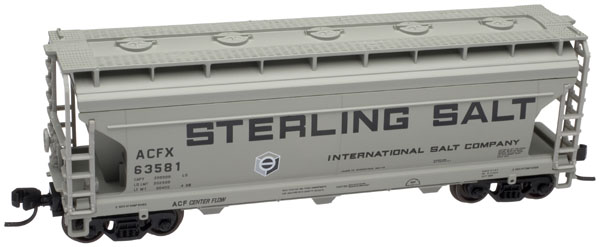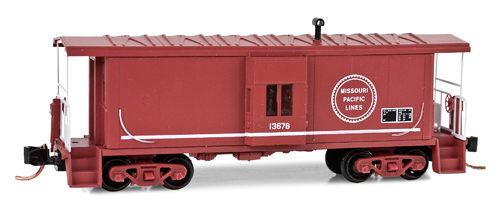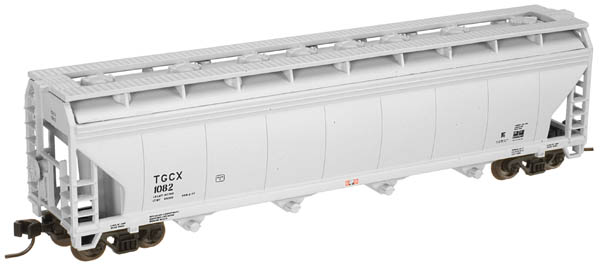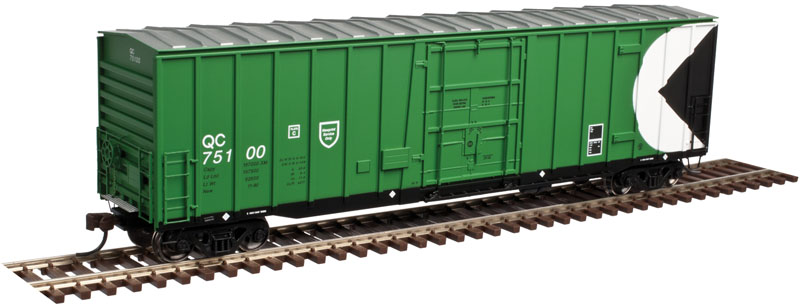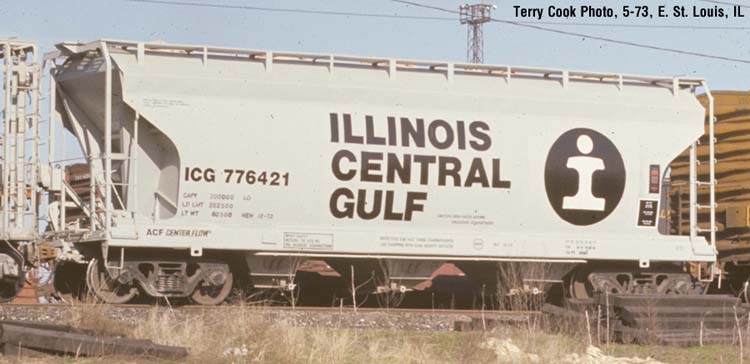Model Information: This model was first released by Atlas in 2006. Unlike many older toolings which were 'put out to pasture' in the Trainman line, this model was Trainman from the get-go. This means it was designed from the ground-up to be durable and relatively inexpensive to produce. It is a nice quality car, and while not as inexpensive as one might hope for an item designed for a lower price point, it is surprisingly well detailed.
Prototype History: Covered hoppers such as these are used to transport any dry bulk material that you don't want exposed to the elements. Salt, fertilizer, some dry chemicals, and bauxite are common loads for this car. Over 200 were built from 1967 to 1972. The three-compartment ACF® 3560 Center Flow Covered Hopper was designed for the transport of high-density dry bulk ladings of 50 – 60 pounds per cubic foot. The 100-ton car was designed to fit into the smallest modern plate diagram dimensions, Plate B.
Road Name History: 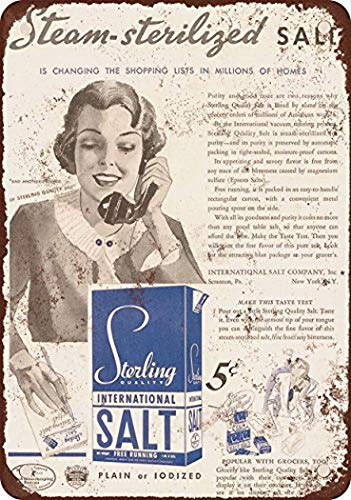 The International Salt Company incorporated on August 22, 1901, and in 1902, the company purchased the stock and assets of the National Salt Company, which had failed. By 1934, International Salt was a holding company for six subsidiaries: Avery Salt Company (West Virginia), Detroit Rock Salt Company (Michigan), Eastern Salt Company (Massachusetts), Independent Salt Company (New York), International Salt Company, Inc. (New York), and Retsof Mining Company (New York). All of the subsidiaries operated rock salt mines and evaporated salt plants and distributed salt. In 1940, the International Salt Company decided to sell four of its subsidiaries--Avery Salt Company, Detroit Rock Salt Company, International Salt Company, Inc., and Retsof Mining Company.
The International Salt Company incorporated on August 22, 1901, and in 1902, the company purchased the stock and assets of the National Salt Company, which had failed. By 1934, International Salt was a holding company for six subsidiaries: Avery Salt Company (West Virginia), Detroit Rock Salt Company (Michigan), Eastern Salt Company (Massachusetts), Independent Salt Company (New York), International Salt Company, Inc. (New York), and Retsof Mining Company (New York). All of the subsidiaries operated rock salt mines and evaporated salt plants and distributed salt. In 1940, the International Salt Company decided to sell four of its subsidiaries--Avery Salt Company, Detroit Rock Salt Company, International Salt Company, Inc., and Retsof Mining Company.
John M. Avery discovered rock salt at Petite Anse, Louisiana in 1862. Petite Anse Island was renamed Avery Island in the late 19th century. Ownership and mining of salt at Petite Anse involved numerous parties until 1886, when New Iberia Salt Company took over operations. In 1896, the Avery family began operating the mine, and they founded the Avery Rock Salt Mining Company. In 1899, the International Salt Company leased the mine.
The Detroit Salt and Manufacturing Company was founded in 1906. The company quickly went bankrupt during construction of a shaft and was acquired in 1910 by the Watkins Salt Company, which incorporated the new organization under the name Detroit Rock Salt Company. The company experienced success and the International Salt Company purchased the mine circa 1914. In 1983, International Salt closed the mine's operations and in 1985, Crystal Mines, Inc., purchased the mine as a potential storage site.
In 1885 the Empire Salt Company of New York was renamed the Retsof Mine Company, and the Village of Retsof was founded near the mine shaft. During the next 110 years, the mine grew to become the largest salt-producing mine in the United States and the second largest in the world. Before the initial collapse in March 1994, the mine encompassed an underground area of more than 6,000 acres, and the mine footprint (outer edge of mined area) extended over an area of nearly ten square miles. At the time of the collapse, the Retsof Mine was owned by Akzo-Nobel Salt Incorporated (ANSI) and, during the winter of 1993–1994 operated at full capacity to meet demands for road salt throughout the northeastern United States. The Retsof Mine ceased operations on September 2, 1995, and by December, twenty-one months after the initial collapse, the mine was completely flooded.
Sterling Salt was one of trademarks of The International Salt Company.

John M. Avery discovered rock salt at Petite Anse, Louisiana in 1862. Petite Anse Island was renamed Avery Island in the late 19th century. Ownership and mining of salt at Petite Anse involved numerous parties until 1886, when New Iberia Salt Company took over operations. In 1896, the Avery family began operating the mine, and they founded the Avery Rock Salt Mining Company. In 1899, the International Salt Company leased the mine.
The Detroit Salt and Manufacturing Company was founded in 1906. The company quickly went bankrupt during construction of a shaft and was acquired in 1910 by the Watkins Salt Company, which incorporated the new organization under the name Detroit Rock Salt Company. The company experienced success and the International Salt Company purchased the mine circa 1914. In 1983, International Salt closed the mine's operations and in 1985, Crystal Mines, Inc., purchased the mine as a potential storage site.
In 1885 the Empire Salt Company of New York was renamed the Retsof Mine Company, and the Village of Retsof was founded near the mine shaft. During the next 110 years, the mine grew to become the largest salt-producing mine in the United States and the second largest in the world. Before the initial collapse in March 1994, the mine encompassed an underground area of more than 6,000 acres, and the mine footprint (outer edge of mined area) extended over an area of nearly ten square miles. At the time of the collapse, the Retsof Mine was owned by Akzo-Nobel Salt Incorporated (ANSI) and, during the winter of 1993–1994 operated at full capacity to meet demands for road salt throughout the northeastern United States. The Retsof Mine ceased operations on September 2, 1995, and by December, twenty-one months after the initial collapse, the mine was completely flooded.
Sterling Salt was one of trademarks of The International Salt Company.
Brand/Importer Information: In 1924 Stephan Schaffan, Sr. founded the Atlas Tool Company in Newark, New Jersey. In 1933 his son, Stephan Schaffan, Jr., came to work for his father at the age of sixteen. Steve Jr. built model airplanes as a hobby and frequented a local hobby shop. Being an enterprising young man, he would often ask the owner if there was anything he could do to earn some extra spending money. Tired of listening to his requests, the hobby-store owner threw some model railroad track parts his way and said, "Here, see if you can improve on this".
In those days, railroad modelers had to assemble and build everything from scratch. Steve Jr. created a "switch kit" which sold so well, that the entire family worked on them in the basement at night, while doing business as usual in the machine shop during the day.
Subsequently, Steve Jr. engineered the stapling of rail to fiber track, along with inventing the first practical rail joiner and pre-assembled turnouts and flexible track. All of these products, and more, helped to popularize model railroading and assisted in the creation of a mass-market hobby. The budding entrepreneur quickly outgrew the limitations of a basement and small garage operation. Realizing they could actually make a living selling track and related products, Steve and his father had the first factory built in Hillside, New Jersey at 413 Florence Avenue in 1947. On September 30, 1949, the Atlas Tool Company was officially incorporated as a New Jersey company.
In 1985, Steve was honored posthumously for his inventions by the Model Railroad Industry Association and was inducted into the Model Railroad Industry Hall of Fame in Baltimore, Maryland. In addition, Steve was nominated and entered into the National Model Railroad Association Pioneers of Model Railroading in 1995.
In the early 1990s, the Atlas Tool Company changed its name to Atlas Model Railroad Company, Inc.
In those days, railroad modelers had to assemble and build everything from scratch. Steve Jr. created a "switch kit" which sold so well, that the entire family worked on them in the basement at night, while doing business as usual in the machine shop during the day.
Subsequently, Steve Jr. engineered the stapling of rail to fiber track, along with inventing the first practical rail joiner and pre-assembled turnouts and flexible track. All of these products, and more, helped to popularize model railroading and assisted in the creation of a mass-market hobby. The budding entrepreneur quickly outgrew the limitations of a basement and small garage operation. Realizing they could actually make a living selling track and related products, Steve and his father had the first factory built in Hillside, New Jersey at 413 Florence Avenue in 1947. On September 30, 1949, the Atlas Tool Company was officially incorporated as a New Jersey company.
In 1985, Steve was honored posthumously for his inventions by the Model Railroad Industry Association and was inducted into the Model Railroad Industry Hall of Fame in Baltimore, Maryland. In addition, Steve was nominated and entered into the National Model Railroad Association Pioneers of Model Railroading in 1995.
In the early 1990s, the Atlas Tool Company changed its name to Atlas Model Railroad Company, Inc.
Item created by: Lethe on 2016-02-05 13:54:19. Last edited by CNW400 on 2020-06-03 11:45:26
If you see errors or missing data in this entry, please feel free to log in and edit it. Anyone with a Gmail account can log in instantly.
If you see errors or missing data in this entry, please feel free to log in and edit it. Anyone with a Gmail account can log in instantly.


